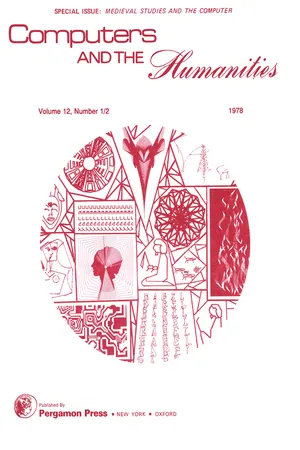
- 232 pages
- English
- PDF
- Available on iOS & Android
About This Book
Medieval Studies and the Computer focuses on the use of computers in medieval studies and humanities research. Topics covered range from encoding and concording texts to the use of conceptual glossaries by medievalists, as well as the use of computers for compiling Middle English lexicography and the Wisconsin Dictionary of the Old Spanish Language. A computer analysis of metrical patterns in the epic Beowulf and of Notker Labeo's Old High German is also presented. Comprised of 26 chapters, this volume begins by discussing "contexts" in concordances and the set of conventions employed in text encoding. The reader is then introduced to the series of initiatives undertaken in Belgium to study Latin literature and linguistics; the use of conceptual glossaries by medieval scholars; and the use of the computer to make a word list of the Decretum Gratiani and to study Geoffrey Chaucer's vocabulary. Subsequent chapters discuss a computer program called KLIC (Key Letter In Context) for graphological analysis; a set of routines written in SAIL (Stanford Artificial Intelligence Language) for use by social historians in quantitative analysis or text processing; and the use of Mark IV, a general-purpose file management system, to analyze medieval charters. This book will be of interest to medievalists, social historians, students and scholars of humanities, and computer scientists.
Frequently asked questions
Information
Table of contents
- Front Cover
- Medieval Studies and the Computer
- Copyright Page
- Table of Contents
- Chapter 1. Guest Editor's Note: Medieval Studies and the Computer
- Chapter 2. Some Considerations Concerning Encoding and Concording Texts
- Chapter 3. Vox Latina: Belgian Initiatives in Data Processing the Intellectual Language of Europe, A. D. 197–1965
- Chapter 4. Conceptual Glossaries: A New Tool for Medievalists
- Chapter 5. An Index Verborum to Gratian's Decretum: The Reason to Computerize It
- Chapter 6. Zur Erstellung einer computerunterstützten Grammatik "Flexionsmorphologie des Frühneuhochdeutschen
- Chapter 7. Computers and the Old Spanish Dictionary
- Chapter 8. Computers and Medieval English Lexicography
- Chapter 9. The Study of Chaucer's Vocabulary
- Chapter 10. A Computer Analysis of Metrical Patterns in Beowulf
- Chapter 11. Towards an Analysis of Notker Labeo's Old High German
- Chapter 12. Dictio probatoria as Fingerprint: Computer Discovery of Manuscript Provenances
- Chapter 13. KLIC: A Computer Aid to Graphological Analysis
- Chapter 14. Möglichkeiten und Grenzen Elektronischer Datenverarbeitung bei der Erforschung der Geschichte des Mittelalters
- Chapter 15. Informatique et Histoire Médiévale à I'lnstitut de Recherche et d'Histoire de Textes
- Chapter 16. Data Base Development and Analysis for the Social Historian: The Educational Status of the Beneficed Clergy of The Diocese of Hereford, 1289-1539
- Chapter 17. Medieval Charters and the Computer: An Analysis Using Mark IV
- Chapter 18. A Prosopographical and Topographical Evaluation of the First Bürgerbuch of Freiburg, Switzerland (1341-1416)
- Chapter 19. The Cognitive Basis of Late Medieval Religious Biographies
- Chapter 20. The Use of Computers in Editing Medieval Baptismal Records in Pisa (1457-1509)
- Chapter 21. From Microfilm to Computer: 15th Century Cadastral and Notarial Archives
- Chapter 22. Projekt "Untersuchungen zu altisländischen Rechtstexten
- Chapter 23. Records of Early English Drama and the Computer
- Chapter 24. Computer Indexing of Illuminated Manuscripts for Use in Medieval Studies
- Chapter 25. A Numerical Taxonomy of Merovingian Coins
- Chapter 26. The Mt. Angel Abbey Manuscript and Rare Books Project: Cataloguing with FAMULUS
- Project Reports